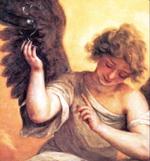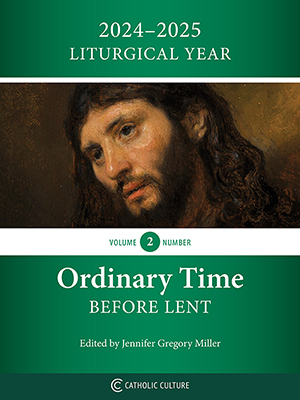Consecrated to Christ: How the 'Vowed Life' Builds Up the Church
The always-relevant theme of the vowed life as publicly professed by consecrated men and women is treated in its own chapter in the Second Vatican Council's Dogmatic Constitution on the Church (Lumen Gentium, nos. 43-47). Forty years after the promulgation of Lumen Gentium, it is time to explore again precisely what the Council Fathers asserted concerning the evangelical councils of poverty, chastity, and obedience and those who profess them.
How can a renewed understanding of Chapter 6, whose title is "Religious" but also has certain application for those in secular institutes and societies of apostolic life, foster a deepened sense of holiness and commitment to the Church on the part of consecrated persons, the clergy, and the lay faithful?
The Text
The teaching and example of Jesus are the source for the evangelical counsels of poverty, chastity, and obedience. Over the centuries, the Church has diligently safeguarded this unique heritage by regulating the practice of the three counsels and establishing "stable forms of living" (no. 43).
Thankfully, various "religious families have come into existence in which spiritual resources are multiplied for the progress in holiness of their members and for the good of the entire Body of Christ" (ibid.). Members of religious families are blessed to have a rule of life and to be joined together as brothers or sisters. The vowed life is not to be seen as the middle ground between the clerical and lay states but is instead "a form of life to which some Christians, both clerical and lay, are called by God so that they may enjoy a special gift of grace in the life of the Church and may contribute, each in his own way, to the saving mission of the Church" (ibid.).
One who publicly professes poverty, chastity, and obedience consecrates himself or herself specifically to serving God for the welfare of the Church. Consecrated men and women testify to "the transcendence of the Kingdom of God and its requirements over all earthly things, bringing home to all men the immeasurable greatness of the power of Christ in His sovereignty and the infinite might of the Holy Spirit which works so marvelously in the Church" (no. 44). The life marked by the profession of the evangelical counsels, "while not entering into the hierarchical structure of the Church, belongs undeniably to her life and holiness" (ibid.).
In order that the love of God may be perfected and the good of humanity perpetuated, the Church's hierarchy regulates the practice of the evangelical counsels and even approves the rules and constitutions of orders. The hierarchy "uses its supervisory and protective authority to ensure that religious institutes established all over the world for building up the Body of Christ may develop and flourish in accordance with the spirit of their founders" (no. 45). The Holy Father can exempt institutes of Christian perfection from the jurisdiction of the local Ordinaries and subject them to himself; however, these institutes still must respect and obey the local bishops.
In a liturgical setting, the Church "receives the vows of those who profess this form of life, asks aid and grace for them from God in her public prayer, commends them to God, and bestows on them a spiritual blessing, associating their self-offering with the Sacrifice of the Eucharist" (ibid.).
Consecrated men and women are conduits through which the Church proclaims Christ to believers and unbelievers. Rather than hinder the development of the human person, the evangelical counsels "contribute in no small degree to the purification of the heart and to spiritual freedom: They continually stimulate one to ardor in the life of love, and above all they have the power to conform the Christian man more fully to that kind of poor and virginal life which Christ the Lord chose for Himself and which His Virgin Mother embraced also" (no. 46). So many saintly founders and foundresses prove this point.
Because it is rooted in the Lord, the consecrated life is concerned with — and assists — the furtherance of human society. The Second Vatican Council saluted those consecrated persons who "adorn the Bride of Christ by the steadfast and humble fidelity of their consecrated lives and give generous service of the most varied kinds to all manner of men" (ibid.).
Consecrated men and women are "to preserve and excel still more" (no. 47) in their state for the glory of the Most Blessed Trinity and for the good of the Church.
Living It Out
Rereading these five short articles from Lumen Gentium only highlights something that we already knew: Consecrated life does not exist apart from Jesus Christ. Consecrated men and women are "successful" and authentic in their living of the evangelical counsels of poverty, chastity, and obedience insofar as they imitate and image the Master.
One important truth is that consecrated persons, by their intense following of Jesus, are to draw our attention to Paradise. Their fidelity to mirroring Christ is to raise our minds and hearts to the eternal truths.
When consecrated men and women deal with material goods and services, they do so for the glory of our Creator and the furtherance of the unceasing Kingdom of God that transcends even the best things that this world affords. Consecrated persons are to be "other-worldly" despite their contact with terrestrial things.
By growing in their relationship with the Lord, those marked with the evangelical counsels of poverty, chastity, and obedience contribute mightily to the holiness of the Church. The Universal Church becomes more what she is destined to be when consecrated persons, by their faithfulness to their unique vocation, testify far and wide to the beauty and splendor of the living Christ.
Seeing this remarkable and perduring witness to God provided by consecrated men and women, the clergy and the lay faithful, who have already been "set aside" by their own public commitment to Jesus the Great High Priest that was illustrated and made effective when they received the Sacrament of Baptism, hearken back to their own consecration and are inspired to intensify their personal love for and service to Christ and His chaste bride the Church for which He suffered and died.
By persevering and reaching new heights of sanctity in their given vocation, consecrated persons both adore the Holy Trinity and offer a sterling example of holiness to all the members of the Church. It is clear that when consecrated life is strong, the whole Church becomes more alive. The clergy and the lay faithful receive much valuable assistance for their own challenging pilgrimage to Heaven from saintly, committed consecrated men and women.
One may rightly claim, using a common contemporary phrase, that consecrated men and women who are loyal to Christ and His Church and who daily embrace the evangelical counsels of poverty, chastity, and obedience provide a "win-win" situation: They themselves deepen in their likeness to Jesus, while the clergy and the lay faithful are encouraged to take the necessary steps to increased spiritual freedom in the Lord who continually summons them to Himself.
Msgr. Charles M. Mangan currently works in Rome as a member of the Vatican's Congregation for Institutes of Consecrated Life and for Societies of Apostolic Life. He is also a Lay Witness columnist (see p. 54) and a member of CUF's Advisory Council.
© Catholics United for the Faith
This item 6609 digitally provided courtesy of CatholicCulture.org






